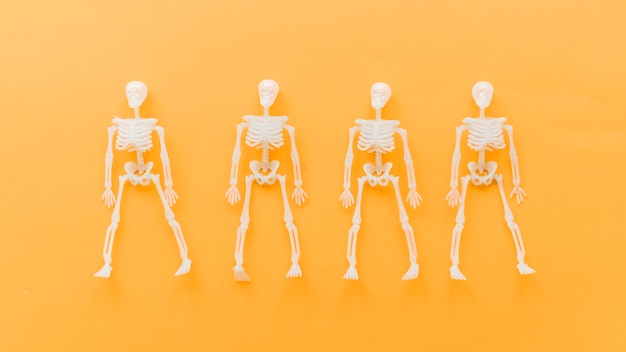Skeletal System Facts

The skeletal system is the framework that supports our body.
The human skeleton consists of over 200 bones.
Our bones are constantly remodeling and growing throughout our lives.
The smallest bone in the human body is the stirrup bone in the ear.
Our skulls are made up of 22 bones.
Babies are born with around 300 bones, but as they grow, some of the bones fuse together.
The femur, or thigh bone, is the longest bone in the human body.
The hyoid bone in our neck is the only bone in our body that is not connected to any other bone.
Bones are made up of 31% organic material and 69% inorganic material.
The human hand has 27 bones.
The bones in our bodies are constantly being broken down and rebuilt.
The spinal column is made up of 33 individual bones called vertebrae.
The clavicle, or collarbone, is the most frequently broken bone in the human body.
Bones help protect our internal organs.
The average adult has 206 bones in their body.
The human skeleton provides stability and allows movement.
The skull protects our brain, which controls all our bodily functions.
The bones in our body store important minerals like calcium and phosphorus.
The skeletal system is necessary for the production of red and white blood cells.
Certain bones, like the patella or kneecap, act like a lever to help us move.
The bones in our body are constantly being nourished and strengthened by our diet and physical activity.
Skeletal System Facts part 2
The ribs protect our lungs and heart.
The bones in our ears help us hear and maintain our body’s balance.
Bones can be used as evidence in forensic investigations to determine age, gender, and cause of death.
The skeletal system provides support for our muscles to attach to.
The human vertebral column has four distinct regions: cervical, thoracic, lumbar, and sacral.
The bones in our fingers and toes are called phalanges.
Our bones are flexible to a certain degree, which helps prevent fractures.
Osteoporosis is a condition where the bones become weak and brittle.
The mandible, or jawbone, is the only movable bone in the skull.
The sacrum is a triangular bone located at the base of the spine.
Bone marrow is responsible for producing cells in our immune system.
Bones have the ability to heal themselves if they are fractured.
Our skeleton gives our body its overall shape and structure.
The pelvic bone in women is wider and shallower than in men to accommodate childbirth.
Bones provide a framework for muscles to work together, allowing us to move.
Bones can be affected by certain diseases, such as osteoarthritis and osteomyelitis.
The skeleton also acts as a storage area for fat, which can be used for energy when needed.
Our vertebral column acts as a protective sheath for our spinal cord.
Some bones, like the skull, are stitched together with fibrous joints called sutures.
The sternum or breastbone connects the ribs in the front of the body.
Bones in the arm include the humerus, radius, and ulna.
The coccyx, or tailbone, is a small triangular bone at the base of the spine.
The skeletal system provides leverage for our muscles to generate movement.
The bones in our body are constantly remodeling and repairing themselves, even as we sleep.

